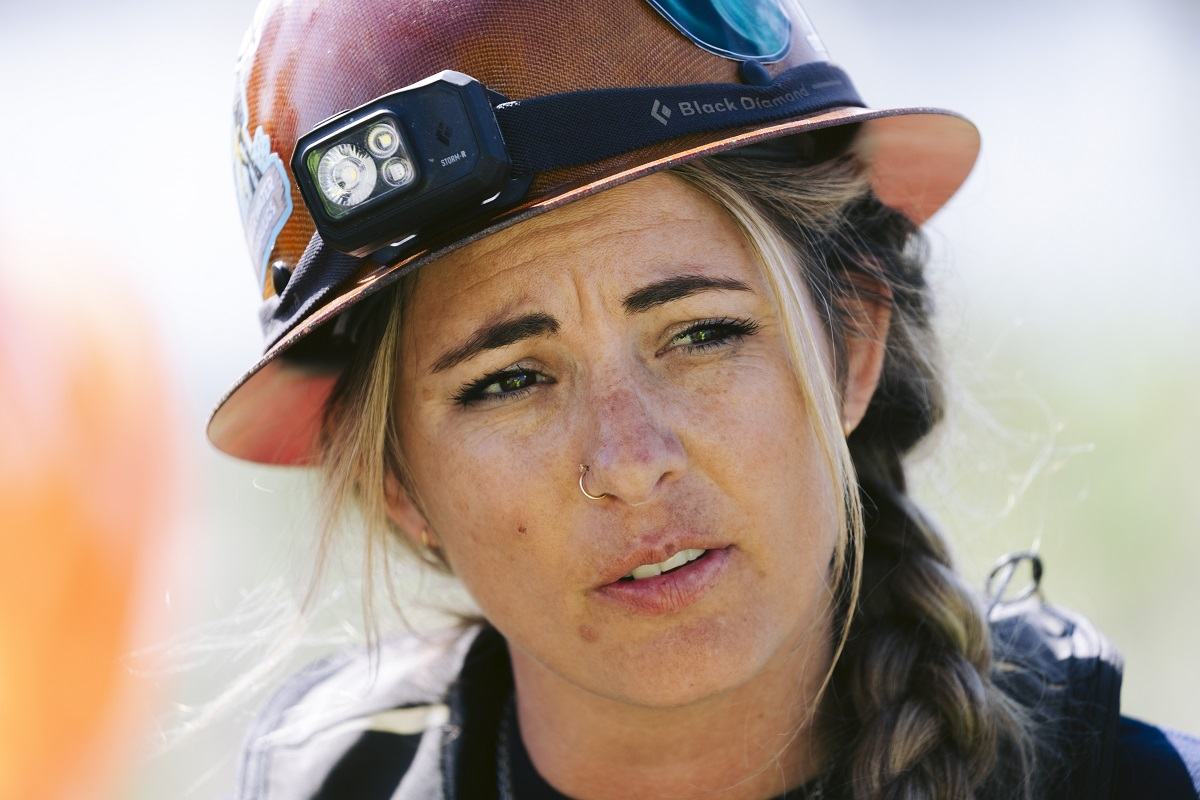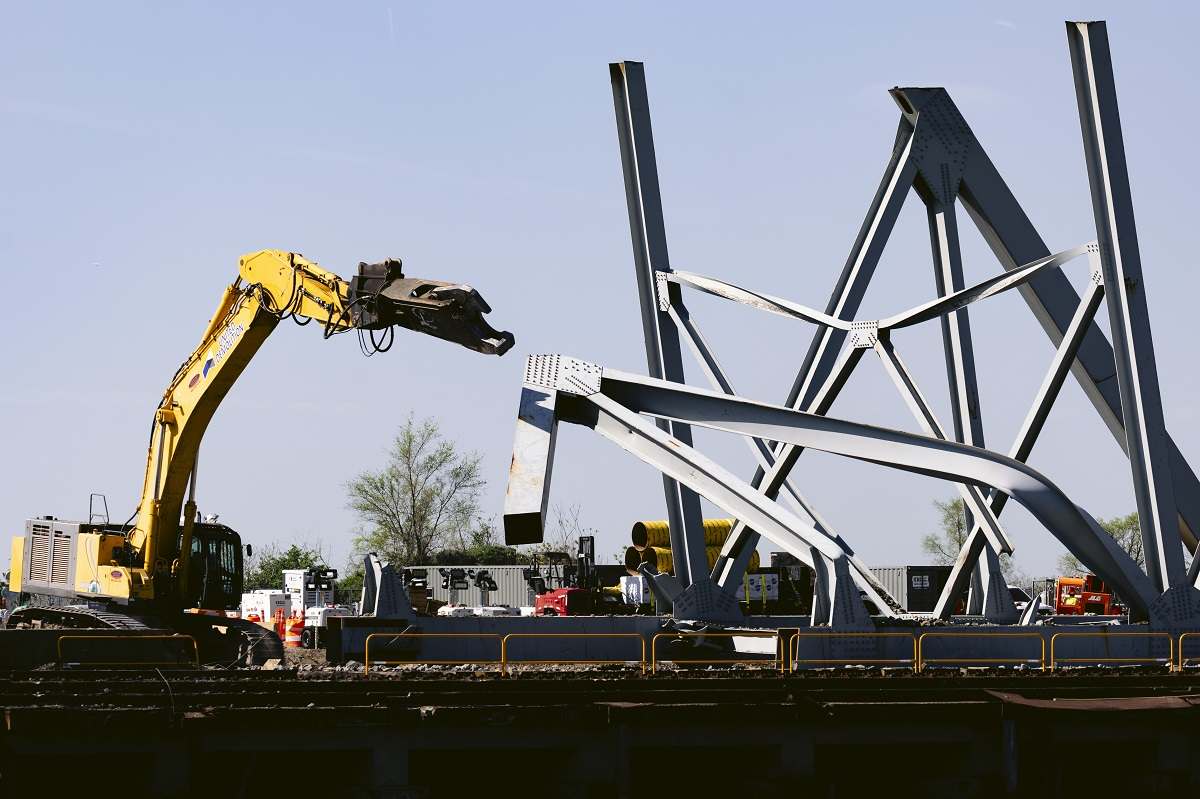
Robyn Bianchi, assistant salvage master at Donjon Marine, speaks to the media Monday in Sparrows Point, Md.
14:05 JST, April 16, 2024
At roughly 450 tons, the hulking piece of the ruined Francis Scott Key Bridge weighed nearly as much as two Statues of Liberty.
To the crews rushing to reopen the Port of Baltimore – who for weeks had hauled and hoisted, lifted and tugged wreckage from the Patapsco River – it stood apart.
The workers had never hoisted a piece so large. Its creeping journey from river to scrapyard illustrates the monumental task of deconstructing in just weeks a massive span that took years to build.
Hundreds of engineers, workers and divers have rushed to the scene of what some say could be the most expensive disaster in maritime history, in which six people are presumed to have perished. Authorities have recovered the bodies of four.

A backhoe with demolition shears bends a recovered steel truss of the collapsed Key Bridge on Monday in Sparrows Point, Md.
Gigantic pieces of steel and concrete in the river have crippled the Port of Baltimore and spread economic pain locally and nationally. Gov. Wes Moore (D) has pledged to reopen the port by the end of May, and the cleanup is a round-the-clock operation.
Sharon Russell, deputy incident commander for the Key Bridge Unified Command, said workers are moving quickly but carefully, balancing the economic imperative of reopening one of the nation’s largest ports and the safety of salvage workers. She said no one has been injured on the project.
“This is incredibly dangerous work,” Russell said. “It’s a remarkably complex project.”
Various officials and salvage experts have compared the disaster recovery to the cleanup that followed the Deepwater Horizon oil spill in the Gulf of Mexico or Hurricane Katrina in New Orleans. But moving the 450-ton piece was a major logistical challenge even by the standards of an already daunting project.
Robyn Bianchi, assistant salvage master with contractor Donjon Marine, said work begins even before the first lift. Divers survey the wreckage 50 feet below the surface, figuring out its contours and where it needs to be cut to lift it.
Teams on the surface guide the divers because visibility can be as little as 1 to 2 feet in the inky, chilly waters. One official likened diving in the Patapsco to driving in a snowstorm with high beams on.
“There’s a lot of debris – a lot of rebar, a lot of concrete,” Bianchi said. “A lot of the time for a first dive we don’t know what dangers are down there, so we have to be methodical and slow.”
An ever-present danger, Bianchi said, is snagging the “umbilical,” a line from the surface that provides divers air. An emergency dive team is always at the ready.
Sal Suarez, U.S. Navy master of salvage and diving, said teams on the surface use hydraulic shears to cut the trusses to sizes big enough for cranes to hoist or divers attach diamond wire saws that clamp on the steel beneath the surface to make cuts.
Officials brought in the Chesapeake 1000, one of the largest floating cranes on the East Coast, to handle the largest chunks of the bridge. On Sunday, it slowly hoisted the section out of the water, the first time it had been used.
The Chesapeake 1000 can hoist up to 1,000 tons, but officials said the large piece ended up being lighter than expected because the roadbed broke free of the bridge and remained on the floor of the Patapsco. Another piece of the same truss remains in the river and will be moved in the coming days.
Suarez said lifting the 450-ton piece was a moment of triumph amid the tragedy.
“It’s moving in the right direction,” Suarez said. “Everyone was thrilled about that.”
The Chesapeake 1000 floated the dangling wreckage to Sparrows Point, an industrial stretch of Baltimore’s waterfront, which was home to a shuttered Bethlehem Steel plant that provided steel for the span in the 1970s. The bridge had come full circle.
The giant section stood about nine stories tall, so crews cut it into two pieces to make it more manageable. On Monday, workers in a cherry picker used a propane torch to slice a piece of the truss, creating a shower of orange sparks.
Later, a backhoe with a crablike claw attachment snipped and pulled at the section of the bridge. At one point, a section of trusses toppled over with a pull from the backhoe. Tons of twisting steel groaned and then hit the ground with a resounding boom, which echoed across Sparrows Point and sent up a cloud of dust.
Nearby, backhoes scooped up sections of the bridge’s roadbed into a pile that had jagged pieces of rebar hanging off it. The rubble is being broken up into chunks small enough to be hauled off by dump trucks. Officials said local companies are helping recycle what they can.
Officials said they remain on a timetable laid out in recent weeks to clear a temporary 35-foot deep channel in the coming weeks to allow more shipping into the Port of Baltimore. They hope to open the full channel by the end of May.
The FBI has opened a criminal probe into the disaster.
“There’s a lot of pressure on us,” Bianchi said. “It’s affecting our economy. We’ve got to get this waterway open.”
"News Services" POPULAR ARTICLE
-

American Playwright Jeremy O. Harris Arrested in Japan on Alleged Drug Smuggling
-

Japan’s Nikkei Stock Average as JGB Yields, Yen Rise on Rate-Hike Bets
-

Japan’s Nikkei Stock Average Licks Wounds after Selloff Sparked by BOJ Hike Bets (UPDATE 1)
-

Japanese Bond Yields Zoom, Stocks Slide as Rate Hike Looms
-

Japan’s Nikkei Stock Average Buoyed by Stable Yen; SoftBank’s Slide Caps Gains (UPDATE 1)
JN ACCESS RANKING
-

Keidanren Chairman Yoshinobu Tsutsui Visits Kashiwazaki-Kariwa Nuclear Power Plant; Inspects New Emergency Safety System
-

Imports of Rare Earths from China Facing Delays, May Be Caused by Deterioration of Japan-China Relations
-

University of Tokyo Professor Discusses Japanese Economic Security in Interview Ahead of Forum
-

Japan Pulls out of Vietnam Nuclear Project, Complicating Hanoi’s Power Plans
-

Govt Aims to Expand NISA Program Lineup, Abolish Age Restriction



















